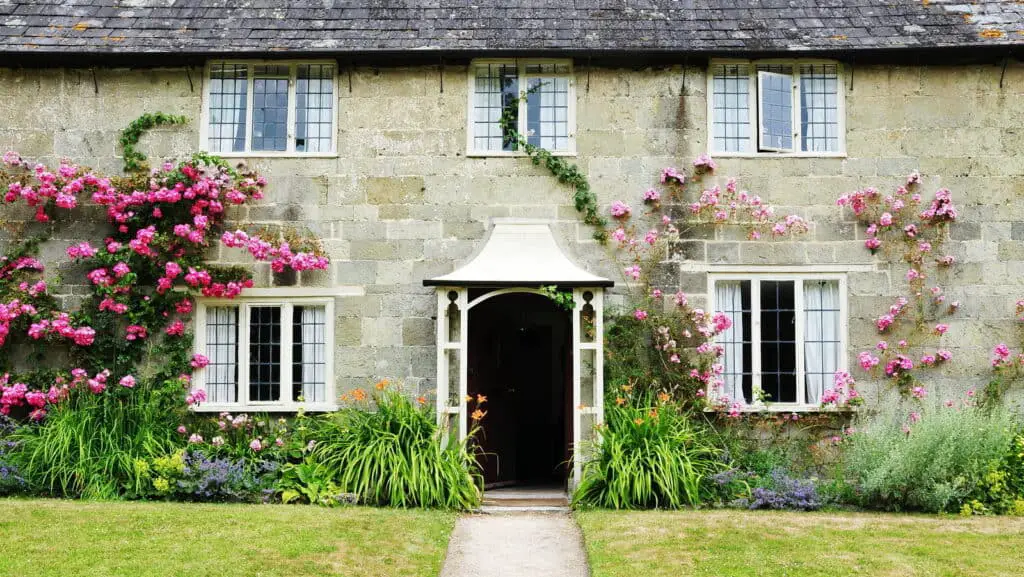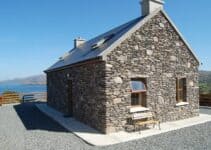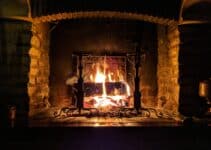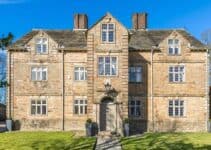There’s just something about cottages that brings a sense of calm into our lives. Peace descends as we unplug from the whirlwind of modern life and step into a rural dwelling which seems to provide a more natural way of life.
It doesn’t matter if you are in the tiniest cottage in the Cotswolds or a gîte in Chablis, cottage life has a certain je ne sais quoi.
But for those who haven’t spent any time in a French cottage, or for that matter, one in England, you may be wondering, what’s the difference? between an English cottage vs a French cottage.
So, for you dyed-in-the-wool city dwellers, we’ve got the low down on what makes a cottage English and what makes it la petite maison.
What is the Difference Between an English Cottage and a French Cottage?
If we went back a hundred years to either France or England, chances are there would be very little difference between what went on inside cottages on either side of the channel.
Cottages by their nature are part and parcel of rural, largely agricultural, life. And as such were likely to house the poorest people in their communities. They would have been constructed with cheap materials and would have been on the small side.
They would also have had highly functional interiors based around cooking, keeping warm and sleeping. After all, for most of the day, the majority of the household would be outside working.
Geographical differences
But the further south you go, the warmer the climate; the further north, the cooler it is. Naturally, this will have some influence on the building materials and the design used in cottage construction.
So while there may not be not as much difference between cottages in Dorset and Normandy, there is likely to be a marked difference between those around Doncaster to those in the Dordogne.
Construction Differences
We certainly wouldn’t want to deny that there are some differences in style between English and French cottages even in times past.
Cottage construction would depend on what was freely available nearby. And, the design may have also been influenced by existing dwellings in the vicinity, or what was considered de rigueur at the time.

Key Differences and Similarities Between Older French and English Cottages
Traditional English and French cottages are both charming and picturesque, but they do have architectural and design differences that reflect the local traditions and styles.
Differences:
The key difference is that English cottages are more likely to be thatched than French cottages, especially the further south in France you go. This is possible because the warm sun made roof tile making much more efficient.
In the scorching Mediterranean sun, thatch would likely set alight! That is not to say thatched roofs don’t exist in France, it’s just a more usual feature of ye olde English cot.
Another difference is that French cottages more often have shutters. Back in the day, it’s likely that many English cottages did too but their windows have since been glazed. French cottages have retained both glass and shutters.
Hanging shutters is likely to be another feature linked conditions in which the cottage is sited. The south of France is notorious for its Mistral – a pervasive wind – and a sturdy pair of shutters would keep out the worst of it.
In summer months, it’s very sunny, so the shutters have a dual purpose during summer as a shade and windbreak in winter and spring. In other areas, such as the Alps and the Pyrenees, shutters would help keep out the arctic blasts.
English weather may be damp and dreary much of the year but it is far less extreme than some areas of France. This means English cottages are more uniform in design across the country than in France.
Similarities:
The most obvious similarity is that cottages are most likely found in rural areas or towns that were once villages.
They were built to house transient or seasonal workers or to encourage migratory workers to stay in one place for longer periods. Whoever they were once homes for, cottages in England or France are an intrinsic part of country life.
Another similarity is that the oldest cottages in both England and France would likely have been single-storey. And if those cottages were permanently inhabited, it’s likely they were extended both outwards and upwards over time.
Whatever form of industry the cottage was linked to, the longer the industry thrived, the longer cottage dwellers were likely to prosper. In this way, a single-storey cottage might have an additional room added or another floor to allow for a growing family.
The building materials would be different from region to region in France just as they would be in England. The building materials would have shared the commonality of being easily available, cheap or free, and locally sourced.
But it’s important to remember that, so far, we have been talking about the traditional cottages of France and England.
And while some cottages may retain their original, rustic charm, it’s very likely that the industrial and technological revolutions have meant the types of people who once worked and lived in cottages were forced to migrate to the city many years ago.
A changing industry and changing lifestyles have meant that the people who are more likely to be found in these quaint rural dwelling places are the middle or upper class from London or Paris on a weekend stay in their holiday cottage.
What is a French cottage?
French cottages are known by a variety of other names. A cottage might be called la petit maison, un chalet, or gîtes, amongst other colloquial terms.
But the type of cottage that’s a la mode in France these days might just as easily be called a ‘maison de campagne’. In English, we’d call this our ‘place in the country’.
If this is the case, you might find that the little French cottage you’ve been invited to is just as likely to be a six-bedroomed home with a pool and vineyard as a two up, two down.
Having said that, in the purest terms ‘cottage’ in France (just as it does in England) refers to a traditional dwelling found in the countryside.
And a cottage in France should embody the rustic charm and simplicity associated with country living.
But we are talking about the French who are known for their keen sense of style and sophistication. So let’s look at the key characteristics of a French cottage:
Architecture
French cottages feature a variety of architectural styles, reflecting the various regional styles and traditions of France. They can range from simple stone cottages to more elaborate structures with elements such as half-timbering, exposed stonework, or stucco exteriors.
Cottages in France typically have steeply pitched roofs, often covered with clay tiles or slate. The roof may have multiple gables, dormer windows, or chimneys.
Windows in French cottages are often large and multi-paned, allowing for plenty of natural light to enter the interior. As mentioned, wooden shutters are commonly used to provide shade, privacy, and protection.
Construction
Common materials used in French cottages include local stone, brick, timber, and sometimes plaster or stucco. The choice of materials depends on the region and local traditions.
Landscaping
French cottages often have charming gardens and courtyards that are meticulously landscaped. As the French are known for their cuisine, you should expect to find plenty of elements within the garden that help to contribute to the table.
This might be through fruit trees or through a bed of herbs. And don’t forget plenty of lavender!
For older cottages, you may also find a water source such as a well. And larger or more modern cottages may even sport a fountain.
Interior Design
The interior design of a French cottage combines the rustic with the refined. Look within and you might see exposed wooden beams, stone or brick walls, and large fireplaces.
Furniture tends to be comfortable but chic, with a mix of vintage or antique pieces, natural materials, and a touch of elegance. Soft colours, or a Breton stripe, and natural textures are often used in fabrics and décor.
What Makes a House an English Cottage?
The characteristics that make a house a cottage in England are usually linked to age, size and location, but there are other factors that contribute to the classification.
Cottages are generally found in hamlets or villages and occasionally in the earliest parts of a town. They are usually small, with a maximum of three bedrooms, and they are generally smaller in dimension with internal rooms being significantly smaller than modern counterparts.
But here are some specifics that might help us narrow down what makes a house a cottage:
- English cottages are typically small to medium-sized, often one or one-and-a-half stories high. They usually have a compact structure, giving them a cosy feel.
- Local materials are commonly used in the construction of an English cottage. This might mean local stone, locally made brick, timber framing or cob depending on the most cheaply available construction material or what would best match existing buildings.
- Thatched roofs are synonymous with the English cottage. Tile or slate can be found but for sheer chocolate-box English cottageness, the roof has got to be thatched.
- The term ‘cottage garden’ was coined to reflect the distinct beauty of English cottage landscaping. Flowers, such as foxgloves, roses, delphiniums, hollyhocks and larkspur nestle cheek-by-jowl with sweet peas and columbine.
- English cottages are typically dimmer than French cottages because of our climate. We tend to spend a lot of the year desiring to be protected from the weather rather than encouraging it into our homes. For this reason, windows are smaller, fires and ranges are more abundant and the rooms are cosier and easier to heat.
While these characteristics represent some traits of an English cottage, it’s worth noting that architectural styles can vary within England and different regions may have their own unique variations of cottage design.
English Cottage Vs French Cottage Living Room
The living rooms in English and French cottages reflect the distinct design styles and cultural influences associated with each country.
Here’s a comparison of the living room features typically found in English and French cottages:
English Cottage Living Room:
English cottage living rooms have a cosy atmosphere. They often feature exposed wooden beams, stone or brick walls and traditional fireplaces, creating a warm and inviting ambience.
The furniture in an English cottage living room tends to be comfortable and inviting. Upholstered sofas and armchairs in floral patterns or natural fabrics are common. And rooms could have built-in storage to save space.
In the south of England, fabrics tend to reflect our warmer climate and love of the garden and we bring the florals indoors to our curtains and seating material.
In the north of England, you may find more woollen materials to keep things cosy and to use locally made fabrics.
French Cottage Living Room:
French cottage living tends to, generally, reflect the warmer climate. The rooms are likely to be airier and more light-filled with a less ‘busy’ aesthetic.
They may also feature more freestanding furniture as French cottages have a little more internal space. Matching furniture sets, paired armchairs, or nested side tables are commonly used to create a harmonious visual arrangement.
French cottage living rooms often have higher ceilings which allows for delicate details, such as moulding, chandeliers, or gilded accents.
Of course, just in the same way as the English cottage style varies from region to region, the French cottage style does too.
English Cottage Vs French Cottage Kitchen
The kitchens of French and English cottages are largely quite similar in size but the appliances will vary depending on the culinary traditions associated with each country.
Both English and French cottage kitchens tend to incorporate the dining space. This means a dining table needs to be included to seat the family at meal times.
Perhaps one difference is the French enjoyment of eating al fresco. So it’s likely the more southern French cottages might have an outdoor dining space too.
Cottages in both countries might have a range or aga for cooking, which would traditionally be log fire. But you may find some regional variation in the cooking accessories used, such as the French preference for brass cookware and the English preference for cast iron.
Both French and English kitchen spaces would require quick and easy cleaning, so stone flooring might be present in both.
And traditional kitchens in both countries may well have a pantry for storing bottled or drying harvested vegetables for long-term use.
English Cottage Vs French Cottage Bedroom
Most people would say that there is very little difference between bedrooms found in France or England apart from the decor. Both require a bed for sleeping.
Apart from the obvious, the difference may lie in the furnishing required of England’s generally cooler climate. This may mean more blankets and sturdier bed linens in England.
And for traditional cottages, it may mean rugs on the wooden floorboards to protect feet from frostbite, especially in more northerly English cottages.
French bedrooms are less likely to have curtains as they have built-in shutters. And when windows are curtained in France, lighter materials such as voile and lace are often used.
English Cottage Vs French Cottage Interior
The interior design does differ between England and France. But some might say there is as much regional difference within the two countries as there is difference between them.
English cottage interiors tend to reflect the compact nature of English cottages. They are built to prioritise warmth.
As such a key feature of an English cottage might be the living space and the focal point being the hearth. A family would enjoy gathering around the fire during our colder months.
French interiors tend to be larger with higher ceilings to allow air and heat to rise and escape. There may also be more access to the outside such as the use of ‘French doors’ in the living space to allow the family to wander in and out of the home to enjoy the warmer climate.
Natural materials play a significant role in English and French cottage interiors. Primarily because cottages tend to use locally sourced and (what used to be) cheaper materials. In modern times, natural materials are likely still preferred to capture the traditional feel of the cottage.
It is likely to find pieces of antique furniture in both English and French cottages. The pieces will vary in style depending on which era the piece is from.
Similar items that may be found in English and French homes left from former times could be dressers, tables, chests or wardrobes.
English Cottage Vs French Cottage Exterior
Architecturally, there are only a few differences between English and French cottages. Both may have started out as very humble dwellings, but over time there will have been modified to last longer and grow with the family’s needs.
So cottages in England and France may be a mix of styles and designs. They will also reflect the local tastes, building techniques and changing laws for home building over time.
It’s likely, though, that French cottages are slightly larger, especially regarding ceiling height. English cottages want to keep heat in, whereas, typically, French homes what to encourage air movement – this reflects their generally warmer climate.
Also, rooves are higher pitched in France than in England which may be a result of the weight ratio required for bearing a considerable amount of thatch.
Outside, too, is one of the main differences: the garden. French gardens may be more landscaped and cater to the culinary aspects of the French lifestyle. While English cottages are famous for their quaint and slightly unstructured cottage gardens.
Conclusion
Whether you’re buying or visiting an English or French cottage you will no doubt be looking forward to stepping into a relaxing and peace-filled environment that lets your stress fall away.
What’s more, you’ll feel a link to the past and a powerful connection with nature that many generations before us would have felt when they made the cottage their home.



